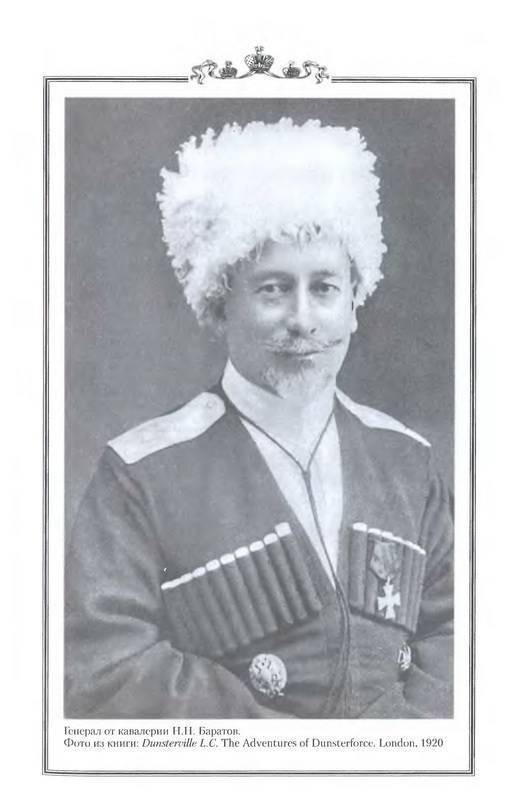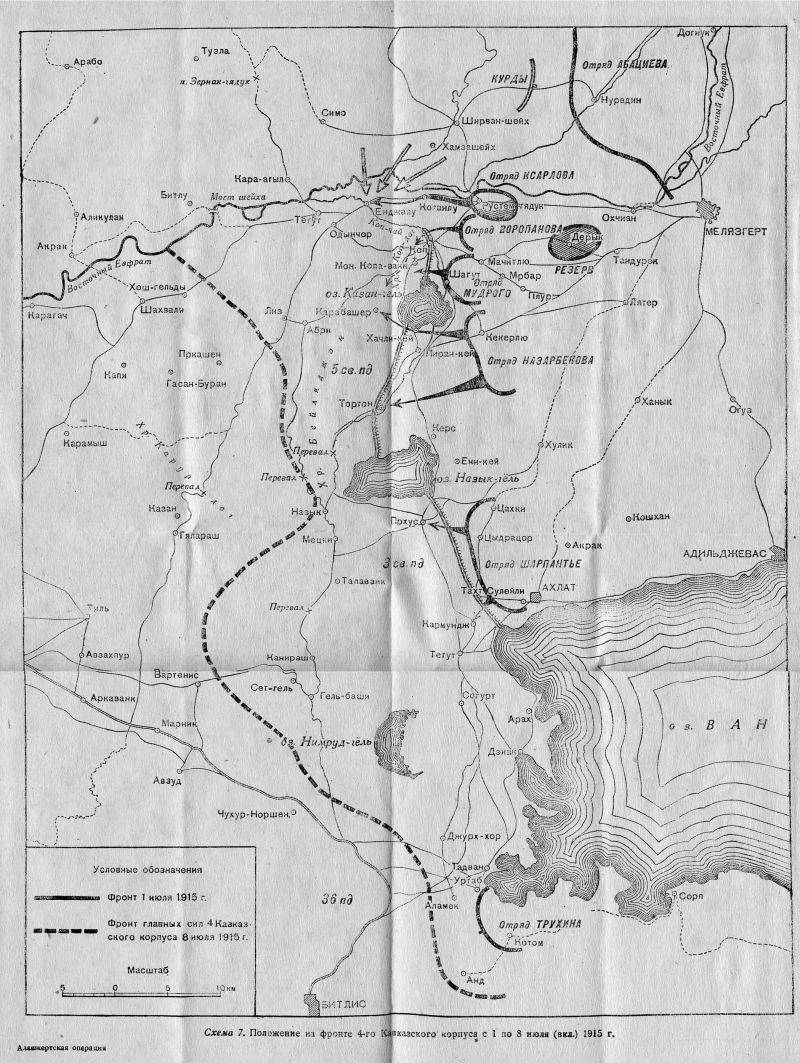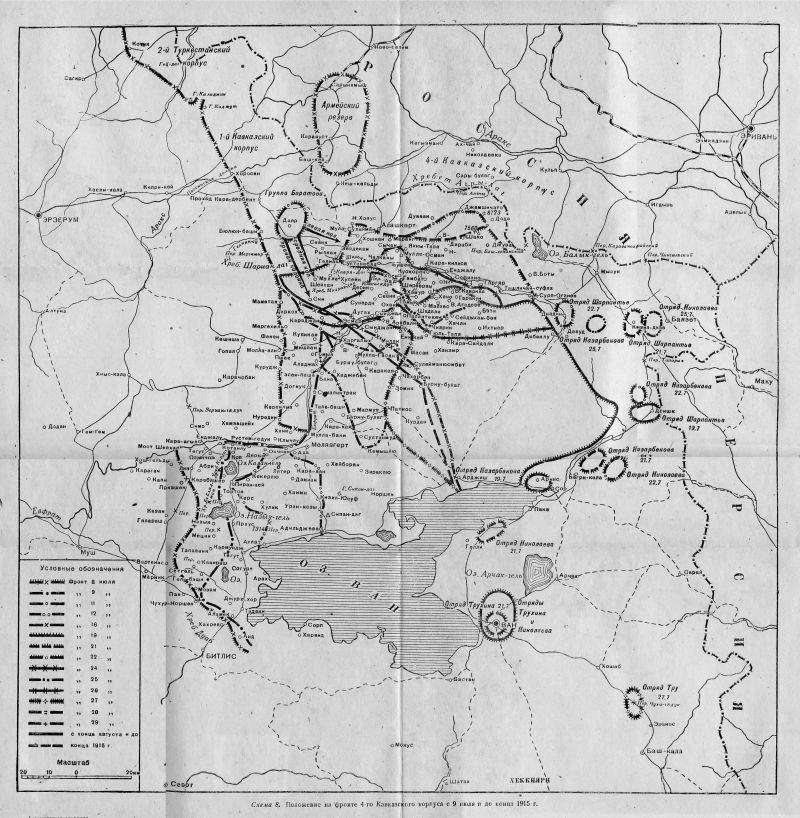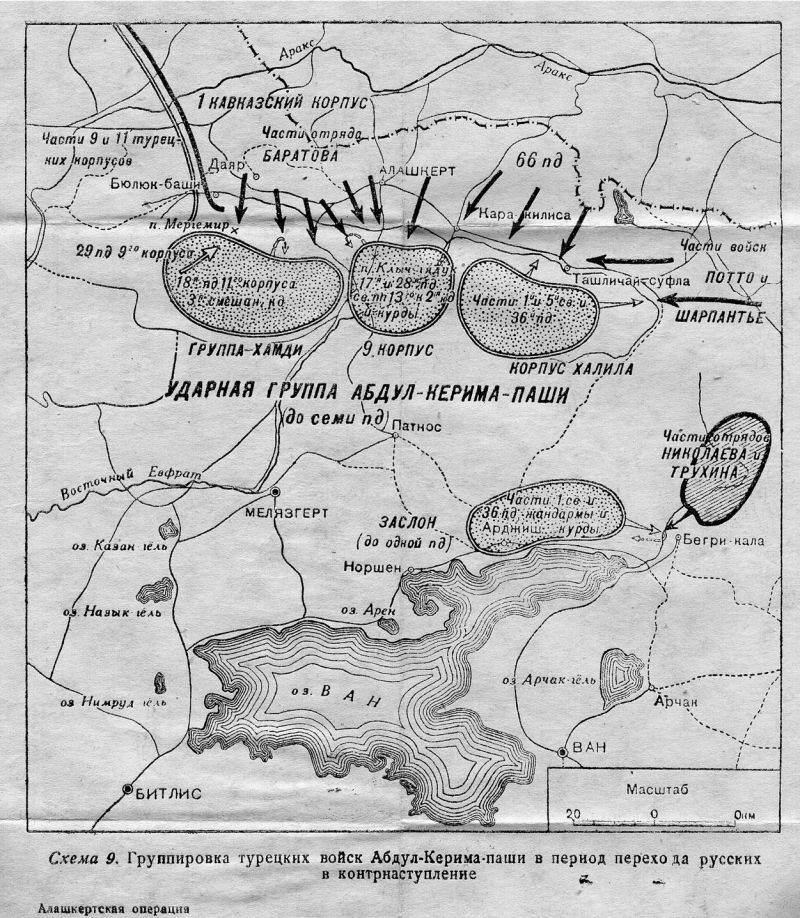Alashkert operation
After successful private operations of the right and left flanks of the Caucasian Army in the spring of 1915, the Russian command planned, holding the enemy in the Sarykamysh direction, to launch an offensive on the flanks of the enemy in the Yolta and Erivan directions. They also planned to conduct a major cavalry raid near Lake Van, threatening the flank and rear of the 3 Turkish army. This made it possible to make a long round of the Erzerum fortifications and disrupt the main communications of the Turkish army in the Caucasus. In the future, the advance of the troops of the left wing of the Caucasian Army provided a basis to outline a broad operation to defeat the 3 of the Turkish army and seize the Erzerum fortress.
However, the lack of troops, insufficient organization of the rear in the area of the alleged offensive and the poverty of the theater of operations by local means, as well as the inability to fully replenish the army with supplies (especially ammunition), led to the headquarters of the Caucasian army decided to abandon the broad operation. The command set the corps a limited operational task and decided to develop active actions only on its left flank. The 4 Caucasian Corps was to capture the Mush, Bitlis and Kop area. In implementing this plan, the Russian troops created a serious threat to the southern flank of the 3 Turkish army. Therefore, the Turkish command had to respond to the actions of the Caucasian army with a counter-maneuver by large forces.
Alashkert operation. Sasun self defense
The left wing of the Caucasian Army, fulfilling the task, gradually moved to the west, pushing the enemy out of the East Euphrates (Murat) river valley. Along the valley of the Eastern Euphrates River, the Turks attacked the Abaciyev detachment, the infantry and Cossack divisions. On the northern shore of Lake Van, the Nazarbekov 2 Infantry Division was moving with cavalry. On the southern shore of Lake Van, along the narrow strip between water and mountains, was the 2-I Trans-Baikal Brigade of General Trukhin with Armenian troops and border guards. In early July, 1915, our troops took the towns of Archavah, Ahlat, Vastan, Zevan and reached the front Melyazgert, Alkhat. Going further, our troops met significant forces of the Turks at the fortified border of Kop - Karmunj. Turkish troops built a solid defense here. On the southern shore of the lake, it passed through mountain heights. And between the northern shore of the large Van Lake and the Euphrates River there were smaller lakes, the Nazyk-gel and Kazan-gel. The gaps between them were protected by fortified positions, and failed to take them on the move.
The Ottoman command, concerned about the activity of the Russians on the right flank of the 3 of the Turkish army, began secretly concentrating additional forces in this direction. The broken hull of Khalil Bey was urgently strengthened. The units came from Syria, transferred 4 divisions from the main grouping of the 3 Turkish army - Erzerum. By early July, the Turks were able to concentrate large forces to counteract parts of the 4 of the Caucasian Corps. At the same time, significant forces continued to be transferred to the combat area.
True, the original position of the Turkish army somewhat complicated the uprising of Armenians in the rear. Since the spring of 1915, alarming news about the pogroms of Armenians in various localities began to reach Sasun district. Christians learned about the extermination of villages around Van and Erzerum, about the massacre in Bitlis and organized self-defense. The authorities incited Kurds against Armenians, but they were repulsed. The situation was dangerous for the authorities. Thousands of Christians resided in Mush only in Mush, and nearby there were about 25 large villages. Turkish authorities have begun negotiations. Sasuns demanded not to touch their area, to refuse from deportation. The local authorities pretended to accept the conditions, while they themselves asked for help from the army command. Abdul Karim Pasha, who took command in this area, sent regular units and Kurdish cavalry.
In March, 1915 Turkish troops and Kurdish bandit formations from the north and south invaded Sasun. In April-May, fierce fighting took place in the areas of the villages of Hulb, Khiank, Ishkhanadzor, Arthonk. Despite the heroic resistance of poorly armed Christians, during which the Turkish troops suffered sensitive losses, the Armenians, under the pressure of superior enemy forces using artillery, were forced to retreat to the mountain of Andok. In June, the Turks launched a new offensive. 25 Jun surrounded Mush. In the countryside, massacred. Cavalry swept through the villages. Some of the inhabitants were killed on the spot, others were driven from mountain villages to the plain. Hundreds of people were stuffed into barns, sheds and barns and burned. So, more than 70 thousand people were destroyed. The few who survived were buried in the mountains, in which they hid and lived like wild beasts until the arrival of Russian troops in 1916. A small part of the Armenians was able to break from the blockade ring to the neighboring regions.
Part of the Armenians sat down in Mush. Together with the peasants, there were about 12 thousand of combat-ready men. They strengthened and repulsed several attacks. They tried to deceive the Armenians, promised an amnesty, let them just disarm and leave the city. Armenians did not believe, knowing that it would end in a massacre. Turkish command, not to repeat story with Wang, sent serious forces - another 2 division, 25 thousand people with 11 guns. 20 — 30 of June (2 - 12 of July) 1915 of the year were fierce battles between the well-armed, numerically superior forces of the Turks and Kurds with the Armenian population of Mush. Armenians stubbornly defended themselves, fought street battles, fought for every home. The Turks shelled the Armenian neighborhoods of the city, destroyed many houses, and caused fires. But the Armenians fought to the last possible; Melee fights often occurred. The Turks suffered heavy losses, but their numerical superiority and dominance in armaments played a role. Several hundred fighters were able to break through the ring of the siege and go to the mountains. The rest died. Turkish troops broke into Mush and completely ravaged it, causing massacre of civilians, women, children and the elderly. Nearby villages also cut out.
A few months later, Russian troops occupied Mush and began an investigation. It was conducted by the captain Shamkhalch of Crimea. He reported: “Usually it was done like this: a large hole was pulled out, women with children were driven to its edges, and mothers were forced to push children into this hole, then the hole was covered with earth a little, then, before the eyes of bound Armenian men, women were raped and killed, after all at last men were killed, corpses filled the pit almost to the top. Some of the Christians were driven to the river and dumped from the bridges into the water, and the swimmers were caught and dropped again. ” There was so much “work” that the mayor of Musha hired professional butchers; they were paid 1 to the Turkish pound a day. "Professionals" routinely slaughtered people like cattle, and did not get distracted by the torture and rape of girls.
Thus, the Turkish civil and military authorities "cleaned" the rear of the Christian population. There are practically no Armenians left in this region.
Source: Korsun N. G. Alashkert and Hamadan operations. M., 1940.
Turkish offensive
On 1 July 1915, the 4 Caucasian Corps had a 52 ½ battalion, hundreds of 122 and a squadron of 90 guns; while 18 battalions, 40 hundreds and 26 guns, that is, about a third of the forces were engaged in the defense of the rear and control of the Persian Azerbaijan. The rest of the corps forces were stretched over a large area from the Mergemir Pass to the southern part of Lake Van. Directly south of the p. Eastern Euphrates to Lake Van were evenly distributed along the front of the 31 battalion, 70 hundreds and squadrons, 54 guns. The corps reserve was extremely weak - only two battalions.
Thus, our troops were stretched on a large front, often in remote, mountainous and desert terrain. The reserve was very weak. Part of the 4 Caucasian Corps controlled the Persian direction and could not immediately take part in the battle. Help from the other corps of the Caucasian army could not quickly come. The enemy had a good opportunity to concentrate on one direction large forces and break through weak Russian defenses.
As a result of the battles that ended by July 4, parts of the 4 Caucasian Corps occupied the fortified Kop-Carmundge line. Turkish troops retreated to the Mus section - Bitlis. Russian troops pursued them in divergent directions. The Russian command had information about the uprising of Christians in the Turkish rear. The commander of the 4 Caucasian Corps, Oganovsky, was preparing to break through the front of the enemy. True, intelligence reported that some Turkish troops were moving towards them, but their forces were underestimated. Oganovsky believed that before him was still the previously broken corps of Khalil Bey, who received some reinforcements.
Meanwhile, significant reinforcements approached the defeated Turkish troops. The Turkish command was able to secretly concentrate to the west of Lake Van a strong strike force led by Abdul-Kerim Pasha - 89 battalions, 48 squadrons and hundreds. As a result, the Turkish army group consisted of more than three corps or about 10 infantry divisions (Hamdi group, 9 corps and consolidated corps of Khalil), 2 cavalry divisions and several thousand Kurdish cavalry. The Russians could only oppose the 2,5 infantry, and the 4 cavalry divisions. At the same time, the troops were heavily scattered, part of the troops was deep in the rear, protecting the liberated areas from the Kurdish and Turkish troops. Transcaspian Cossack Brigade stood in Van, 4-I Cossack Division in Bash-Kale.
Starting from 4 (16) in July, Turkish troops tried west of the Kop to move to the left bank of the r. Eastern Euphrates. To eliminate the threat posed, the Russian command took measures: a part of the troops operating south of the Euphrates was assigned to the Kop area; the center and the left wing of the corps, pursuing the enemy west of Van, slowly moved to the cities of Mush and Bitlis, as they feared the enemy's flank attacks.
On July 9, Turkish troops operating in the Mush area unexpectedly launched an offensive on the entire front. Fighting began at the front of the Kop, Gel-Bashi. The moment was chosen very well. The shock corps of the Russian corps — the 66 Infantry Division of General Voropanov and the 4 of the Kuban Plastun Brigade of the Wise, advanced along the southern coast of the Euphrates on the 25-30 km, the Abaciyev detachment on the northern coast was behind. On the left flank of the 2-I division Nazarbekov rested against the mountains and also fell behind.
Turkish troops tried to reach the right flank of the 4 Caucasian Corps, push the Russians into the desert and sparsely populated area of the northern shore of Lake Van, and at the same time intercept the main corps communications that passed to the Ahta pass in the East Euphrates River valley. After the defeat of the main forces of 4 of the Caucasian Corps, the Turks planned to go on the offensive on Alashkert, from the south to go to the rear of the Sarykamysh group of the Russian army, break it up, opening the way to Kars and further to Transcaucasia.
For the headquarters of the 4 Caucasian Corps, this powerful blow of the enemy was completely unexpected. The Russian command did not suspect that such forces were deployed against the corps. The Turkish divisions rather easily found weak spots on a broad front that could not be closed, bypassing the Russians. The Turks forced the Euphrates, breaking through to the rear of the 66 Division and Reeves. Once in ticks, our soldiers desperately fought back and rolled back in order not to fall into the "cauldron." One Kuban battalion was surrounded, fought the whole day without contact with its own men, suffered great losses, but broke through to its own. Oganovsky sent from the reserve Don Plastun brigade Voloshin-Petrichenko. It was an "experimental" connection, as before the Don team did not act as cleats. In the first battle, a weak corps reserve was overturned.
Under pressure from the superior forces of the enemy, the Russian units defending in the Kop region withdrew to the region west of Melasgert, and those operating to the south began to withdraw to Adildzhevas. On July 12, our troops (the main corps forces - the 22 battalion) fought at the position at Melyazgert. Oganovsky threw into the battle all that he had, even a convoy of headquarters. Our troops tried to go on the counter. However, the Turks were too many. The Turkish command introduced all new forces into battle. Russian counterattack repulsed. Our troops could not resist and, restraining the enemy by the rear-guard, began to retreat further to the northeast. 16 July Russian troops fought with the enemy in the position of Syndzhan, 19 of July - in the position of Palanteken. Under the threat of bypassing large forces from the left flank, the Russian corps continued its retreat. On July 20, fighting continued in the Alashkert Valley.
The Trans-Baikal brigade Trukhin and the Armenian squads on the southern flank of the corps turned out to be alone. The connection has been lost. Against them, the Turks were few, barriers. But the front collapsed, all communications in the north filled Turkish troops. The detachment began to retreat in a roundabout way, along the southern shore of Lake Van towards the city of Van. The Transcaspian Cossack Brigade of Nikolaev was located here and the situation was peaceful. However, these troops were required in the north, where a fierce battle raged. The Transcaspian and 2-I Trans-Baikal Brigades received a tough order - to leave Van and retreat to Bayazet. These troops were supposed to cover the hole in the front. It was a difficult decision, along with the Russians, the entire Christian population was gone.
Together with the Russians, the remaining Christian population of the region was leaving. Almost all capable inhabitants of the region left with our soldiers - about 200 thousand people. The refugees made a big mess to the troops, were frightened by any noise, blocked up the roads. They needed to be protected. This dramatically reduced the combat capability of the Russian units. However, it was impossible to leave the refugees, they were threatened with fierce death. Often, the Russian infantry and cavalry served as a simple cover for refugee convoys. Leaving people was impossible. Wild Kurds slaughtered, raped and castrated not only Christian refugees, but also Russian prisoners. Turks and Kurds followed our troops and refugees, trying to break into the columns of defenseless refugees, to split off part of them, to rob and cut. Therefore, our soldiers, the Cossacks fought without sparing themselves, restraining the enemy with desperate rearguard battles. In these battles, only a fifth of the 4 th Pluton Brigade survived.
And yet many civilians could not be saved, and were killed in the most brutal way. Thus, the former cornet Yeliseyev in reconnaissance wrote: “From the high rocky shores of the deep gorge, as far as the eye could reach the south and north, corpses of people lay on it in patches. The departure went down. The picture is even more terrible than it seemed from above. Women and children singly and in small groups, apparently with families, strewn all the way along the gorge. Occasionally, Armenian men came across their own carts, without buffaloes and plundered. All adults with slit throats, children killed with sharp hammers ... victim's throat. The picture was terrible and shameful. It was quiet in the gorge. The Cossacks were silent ... ”
The Turkish authorities, after seizing a number of settlements, were accused of Russian atrocities. Like, it was the Russians who slaughtered the local population. In fact, the Turks began the massacre in the spring of 1915, and now they did it. All Christians who could not leave with the Russians or hesitated for one reason or another were put to cruel death. In the same Van expounded over the old and the sick. In a fit of wild hatred, they destroyed houses and killed even dogs and cats.
Kontrudar Baratova
The commander of the Caucasian army, Yudenich, taking into account the threatening situation on the left wing of the army, concentrated an army reserve in Sarykamysh, Karakurt, reinforcing it at the expense of the 2 of the Turkestan and 1 of the Caucasian corps. On the Erzurum direction they strengthened the fortifications in order to remove part of the troops. At the same time, most of the Russian forces, which were located in the vicinity of Lake Van, were sent in circular ways to the Tapariz Pass (south of Bayazet) and further to the Diadin area to join the main forces of the 4 Caucasian Corps.
After making sure that the Ottomans really concentrated large forces against the southern wing of the Caucasian Army and that the 4 Caucasian Corps was unable to cope with the threat independently, Yudenich decided to produce a counter-maneuver in order to defeat the group Abdul-Kerim Pasha. To do this, the 4 Caucasian Corps had to conduct mobile defenses, stifle enemy forces and retreat to the Ahty pass. At the same time, a barrier was created to cover the Diadinskaya and Beyazet valleys, which was supposed to carry the Ottomans in the direction of the Tashlichay souffle. Meanwhile, an army group under the command of General Baratov was forced into the army reserve by force near the corps reinforced with cavalry, which concentrated on the left flank of the enemy's attack force in the Dayar area. The Baratov group was to deliver a strong blow to the left flank and rear of the Abdul-Kerim Pasha group, held down by the battles with the 4-th Caucasian Corps. At this time, the 4-th Caucasian Corps left in the Alashkert valley, the rearguard of Kara-Kilis moved to the north, taking positions with V. Darabi. The defensive squad was at Surp-Oganez.
In addition, the Russian command, realizing that the Turks, concentrating all free forces on the southern flank of the 3 Army, weakened attention on the Erzurum and Altine sectors, ordered the 2 th Turkestan and 1 Caucasian corps to go on the offensive across the front with the aim of to forge the forces of the enemy. However, due to the lack of ammunition, this problem was only partially solved.
21 July 1915. Turkish troops continued their offensive against the main forces of the 4 Caucasian Corps, bypassing its left flank in the direction of Jura. Therefore, the Russian troops on the night of July 22 retreated to the position of Jamshichino.
The Baratov group completed its concentration in the evening of 21 July in the Dayar area: 24 battalion, 1 militia, 31 hundred. On July 22, the Baratov group in three columns launched an offensive from the Alashkert valley towards the Klych-Gyaduk passes. Russian troops had to go into the valley of the Eastern Euphrates River, intercepting convenient retreat routes to the Turkish forces along the right bank of this river and strike the flank and rear of the group of the Turkish army that was advancing against the main forces of the 4 Caucasian Corps. On the same day, the troops of the 4 Caucasian Corps received an order to launch a general counterattack, but they could only do this the next day.
The Turks were stunned. The troops of Abdul-Kerim Pasha were carried away by the pursuit, stretched out on the march. And suddenly flank attack of Russian troops. But Oganovsky’s troops, which the Turks had already discounted, were confident that the 4-nd Caucasian Corps was defeated, it was only necessary to finish it, suddenly turned around and without pause went into a frontal counterattack on the two Turkish corps, which were chasing them.

The group Abdul-Kerim Pasha began a hasty retreat, throwing carts. In order to counter the Russian offensive, the Turkish command advanced the 29 Infantry Division from the Passinskaya Valley to the flank of the Baratov group on the Mergemir Pass. This slowed the pace of movement of Baratov’s troops. Meanwhile, the main forces of the 4 Caucasian Corps, reinforced by detachments coming from the area of Lake Van, launched an offensive.
The forces of the Russian cavalry were dispersed, the rear worked poorly, they failed to establish normal interaction between the Baratov group and the 4 of the Caucasian corps, therefore it was not possible to destroy the main forces of the Turkish group. The Turkish group, having lost many soldiers killed, wounded and 10 thousand people prisoners, was able to escape. However, the widely-conceived German-Turkish command, a breakthrough in the direction of Kars was thwarted, and the Russian army won a victory in this difficult battle.
In early August, 1915, due to heavy fatigue of troops and problems with the delivery of supplies, Russian troops stopped. 4-th Caucasian Corps, pushed Turkish troops back to their initial positions, at the end of the operation occupied the front from the Mergemir Pass to Burnubulag. To the south, up to the Arjish district, there were only observation posts and an equestrian reconnaissance ahead.
For this victory, the commander-in-chief of the Caucasian army Vorontsov-Dashkov and her commander Yudenich were awarded orders of St. George 3 degree. Oganovsky removed from office.
- Alexander Samsonov
- 1915 Campaign
Military plans of the Entente and the Central Powers for 1915 year
Death of the 20 Russian Corps
"Rubber War" in the Carpathians
Battle for Prasnysh
Italian "jackal" enters the war
Battle of the Isonzo
Second Battle of the Isonzo
Germany turns east
Bosphorus bait for Russia
Gorlitsky breakthrough
The defeat of the 3 Army Radko-Dmitriev. The death of the 48 "Steel" division of General Kornilov
Departure of Russian armies from Galicia. Loss of Przemysl and Lviv
The great retreat of the Russian army
The fall of Warsaw
Fall of the Newgeorg Fortress
The great retreat of the Russian army was the harbinger of the 1917 disaster of the year.
1915 Campaign of the Year on the Caucasus Front
Solution of the “Christian Question” in Turkey during the First World War
Battle for van



Information